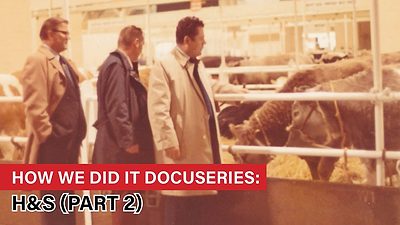Dealership transitions can be an intimidating process, but with advanced preparation, effective structure and proper generational considerations, it doesn’t have to be as daunting.
Having orchestrated over 150 transactions in the last 10 years, Lance Formwalt is passionate about assisting with dealership transitions and succession planning. As the general counsel for the North American Equipment Dealer Assn. (NAEDA) and attorney with Siegfried Bingham in Kansas City, Kan., Formwalt spends most of his time working directly with equipment dealers and dealer associations.
“I’m not going to tell you I have every answer or that it’s easy. What I really want to tell you is the transition process is complicated. And part of that is just understanding you’re in the middle of it,” he says.
Takeaways
- Establish an independent board of directors who are not employees, owners or family. These people should add value to the dealership and be skilled in focusing on strategic oversight rather than the day-to-day.
- There are several ways to transfer ownership to a family member while minimizing tax impact, including passing on stock or splitting that stock into voting and non-voting.
- ESOPs allow employees to own majority stock in the dealership, while keeping control in the hands of the board of directors and owner. It can also make generational transfers and other transitions smoother.
When considering a dealership transition, Formwalt urges dealers to assess their current situation. Manufacturers have influence over the direction of business, and nearby buyers and sellers may change the economic landscape. The merits of current employees and management teams must also be considered when moving through a transition. Family, however, can be the hardest to deal with, according to Formwalt.
Despite dealers' intentions, transitions are not straightforward or simple. Every group that can influence business operations will also influence the transition process.
“As you go through your career, whether it’s as an owner or as an employee, you feel like you’re in a hamster wheel, and hopefully someday you gradually move up, but you’re always reacting to people changing their positions,” Formwalt says. “Manufacturers are a good example. They may change their strategy, and that has an impact on you and how you think about your plan. You’re gradually moving up, you get to the top, you finally execute that transition, and then someone else comes in behind you. Whether it’s the next generation owners or next generation of employees, it never stops, so it’s not easy. ”
Preparing for a Transition
A formalized business structure, regardless of dealer size, can help simplify management decisions, especially in family-run operations that may focus too heavily on daily responsibilities without considering the bigger picture, according to Formwalt.
In order to avoid this, he recommends assembling an independent board of directors — people who are not owners, employees or family — to help keep the transition process as impartial and productive as possible.

When deciding on board members, consider the value they will add to the business. Where is there a need and how can this person fill it? It could be in manufacturer relations, finance or growth. Another important quality in a board member is knowing how to focus on strategic oversight and long-term success rather than getting bogged down by day-to-day operations.
Formwalt, who serves on several dealer boards of directors, insists on a yearly succession planning discussion.
“What does that look like for the business, the ownership?” he says. “What’s it look like for the management team? If you’re not asking about your CEO’s succession plan, you’re asking for problems. You have to think about where you’re going long-term as an organization. The answer is going to be different for everybody, but if you can’t get to a structure that allows you to have that conversation, you’re going to have a problem.”
The structure that a board of directors provides allows dealers to start down the path toward a future transition, which requires forethought and planning years in advance.
“You may be 60 years old, and you’re in buying mode,” Formwalt says. “You’re growing that dealership. But if you have an honest conversation with yourself or other people, what is it going to look like when you’re 70? Are you still going to be growing? Or are you building something to eventually sell?”
Before a dealer gets to the point of becoming a seller, they have to be a buyer. To be attractive on the market, a business may want to add product lines or locations to keep other dealers out of that territory. Even in non-exclusive contracts, Formwalt emphasizes that territory is valuable, and dealers should protect that.
“If you’re not asking about your CEO’s succession plan, you’re asking for problems…”
When a dealership owns several locations — a minimum of 5-10, says Formwalt — a buyer can view them as a singular entity that controls a region. This strengthens the dealer’s market appeal, reducing the threat of adjacent dealerships. However, with fewer locations, it’s easier to get surrounded and bought out. Expansion and acquisitions long in advance of a transition can prevent these issues from occurring.
In a long-term development mindset, cultivating a strong internal management team can be a valuable asset. A solid organization allows the dealership to run smoothly in the midst of and after an ownership transition. Manufacturers also want to make sure dealers have stability in their management structure in order to feel comfortable growing with them. Potential buyers want the same.
“If you have a management team in place beside you, somebody other than an adjacent dealer may be able to buy you,” Formwalt says. “Someone may be willing to invest in you. But they’re not going to invest in you unless there’s a management team there that’ll stay in place after you’re gone.”
Planning years in advance not only fosters peace of mind, it gives dealers time to experiment. Whether that means tweaking internal management, manufacturer relations, acquiring additional locations, pursuing an exclusive contract with a single brand or investing in a wholesale business, more time to explore lets dealers perfect their operation prior to the transition process.
Letting Go of Control
Despite comprehensive legal planning, there are some owners who have a difficult time giving up their business.
“There’s often a dynamic of 'I want to control how my kids are going to work in this business down the road, even after I’m gone. I want to control it from the grave.' And generally, I’m not a big fan of that idea. You have to let the next generation come up and run things,” Lance Formwalt says.
His way to avoid conflict is to put together a buy-sell agreement that gives successors a starting point for management and communication in the dealership and the industry.
“Someday everybody’s going to sell some part of their business, so do you have a sellable business?" Formwalt says. "If you’ve got time, what would you do to make your business sellable? You need to have an honest conversation with yourself about that."
Generational Transfers
Instead of selling to an outside buyer, many family-run operations view the dealership as an investment that produces a return and look toward generational transfers.
From a tax perspective, it can be wise to hold onto a dealership as long as possible. Currently, individuals can give close to $13 million to their spouse during their lifetime or after death without paying an estate tax. Similarly, if a dealer distributes stock to their children, the children won’t have to pay capital gains taxes.
“From a tax loss standpoint, there’s a big incentive for those of you in the older generation to hang onto your business because of the incentive to maximize tax savings,” Formwalt says. “But the problem is you have manufacturers out there that have to approve what’s going on in your transition plan.”
Many manufacturers, he explains, won’t be comfortable transferring a dealership to the owner’s child a decade or more in the future. To get around this, Formwalt recommends maintaining open communication with manufacturers and slowly introducing family to the business. The more responsibility a successor has before a transition, the easier it will be to get a manufacturer to agree to a generational transfer.
One method of smoothing over a transition for a manufacturer is to split the dealership into voting and non-voting stock.
“You have to let the next generation come up and run things…”
“You can create non-voting stock that owns most of your business — most of the economic value is there — but the control can be in the voting stock,” Formwalt says. “If you can get rid of that economic value, that manufacturer may be more willing down the road to allow that transition to happen.”
What helps is to understand dealer laws, which protect the relationship dealers have with manufacturers and impacts their ability to approve or deny ownership transfers. Additionally, where dealers are located in the U.S. can affect those protections. Formwalt advises researching those regulations in order to better plan for a generational transfer.
Employee Ownership
Establishing an employee stock ownership plan (ESOP) can also make the dealership transition process smoother by transferring majority stock to employees while providing them with 401k benefits.
“The employees have a retirement account that's based on the value of your dealership, and that ESOP is overseen by a trustee,” Formwalt explains. “It's not you as a seller. Normally it will be a third party that you hire, and it makes sure you follow the rules of the road.”
This third-party trustee purchases the dealership’s stock by borrowing money from a bank. In general, Formwalt says banks will lend 50% of the value of the business and dealers will have to provide the remaining 50%. This creates a guaranteed buyer for the dealership, the value of which is not based on neighboring dealerships or potential buyers but internal data.
Because ESOPs by and large don’t pay taxes, capital that would otherwise be unavailable can be put toward acquisitions or growing the business prior to a transition. This allows the dealership to get the best tax treatment possible and can simplify the transition process by eliminating a complicated transfer of assets.
Meanwhile, everyday operations remain essentially unchanged, according to Formwalt.
“The employees now have the value of the company, but the company’s being run by a trustee — the shareholder — which just votes on selling and merging the business,” he says. “Other than that, it’s the board. Then you’ve got your management team. At the end of the day, not a whole lot changes. You’ve got a few tax law compliances. There’s a little mindset change in terms of sharing information about the value of your company with your employees, but the actual running of the business doesn’t change.”
Selling or Merging
Once a dealership is ready to begin the selling process, it can narrow down the amount of practical buyers depending on the value of the dealership and surrounding businesses. Then, a 15-page sales pitch book can be developed to target interested parties and offer a concise summary of the business.
“If you are a one-store dealer carrying more shortlines or work with manufacturers that aren’t too involved in the sales or approval process, then using a broker who can talk to local contacts may be a viable option,” Formwalt says. “Or, if you’re a big dealer with a billion dollars in sales, you should consider an investment banker who’s identifying private equity groups that can bring in alternative sources of financing for you to allow a transaction to happen.”
“Someday everybody’s going to sell some part of their business, so do you have a sellable business…”
As the buyer of a dealership, appearances do matter. A seller may not want to do business with a buyer who they believe treats their employees poorly. Maintaining positive dealer relationships can eliminate this issue before it starts.
Mergers require the same relationship development and have become increasingly common over the last 25 years because of its tax-free cost-effective nature.
“As long as about 40% of a dealership sticks around in terms of ownership, you can buy out the other 60% and still do a tax-free merger with that 40%,” Formwalt explains. “There’s a lot of flexibility in trying to create a structure that can work for you where you preserve the ability to minimize the impact on your equity when you orchestrate a deal.”
The cons, however, are in the definition. Merging 2 businesses together takes an incredible amount of effort and requires the hiring of an advisor like Formwalt. Once an initial agreed-upon valuation is made, ideally by a third party, then the details such as taxes and company policy can be ironed out.
Both processes are complicated but have their advantages depending on what’s best for individual dealerships. Mergers are the most cost effective, while transitions offer the most control by preparing years in advance with good management practices and dealer structure, family succession planning and a growth mindset.
Check Out Parts 2 & 3 Here
Part 2: “How to Accurately Assess the Value of Your Dealership“ Farm-Equipment.com/articles/22217
Part 3: “Assess Dealer Culture & Values To Ensure Success After a Transition“ Farm-Equipment.com/articles/22311








Post a comment
Report Abusive Comment